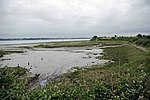Royal Hospital School
The Royal Hospital School (usually shortened as "RHS" and historically nicknamed "The Cradle of the Navy") is a British co-educational fee-charging boarding and day school with naval traditions. The school admits pupils from age 11 to 18 (Years 7 to 13) through Common Entrance or the school's own exam. The school is regulated by Acts of Parliament.The school is located in the village of Holbrook, near Ipswich, Suffolk, England. The school's campus is of Queen Anne style and set in 200 acres (0.81 km2) countryside overlooking the River Stour, Suffolk on the Shotley Peninsula in an area known as Constable Country. The Royal Hospital School was established by a royal charter in 1712. It was originally located at Greenwich Hospital in Greenwich. The school moved in 1933 to East Anglia. The school is the only United Kingdom independent boarding school to have ever been continuously granted the Queen's Banner and it flies its own Admiralty-approved Royal Hospital School Blue Ensign. It is one of only two UK schools whose students have the privilege of wearing Royal Navy uniforms, the other being Pangbourne College in Berkshire. The school is affiliated to the Headmasters' and Headmistresses' Conference (HMC). Bernard de Neumann, a former pupil, described the school's significance as such: "Just as, according to the Duke of Wellington, the Battle of Waterloo was won on the playing fields of Eton, it may justifiably be claimed, that the establishment of... the British Empire, was charted and plotted in the classroom of... the Royal Hospital School."
Excerpt from the Wikipedia article Royal Hospital School (License: CC BY-SA 3.0, Authors).Royal Hospital School
B1080,
Geographical coordinates (GPS) Address Phone number Website External links Nearby Places Show on map
Geographical coordinates (GPS)
| Latitude | Longitude |
|---|---|
| N 51.9723 ° | E 1.1497 ° |
Address
Royal Hospital School
B1080
IP9 2RX
England, United Kingdom
Open on Google Maps







